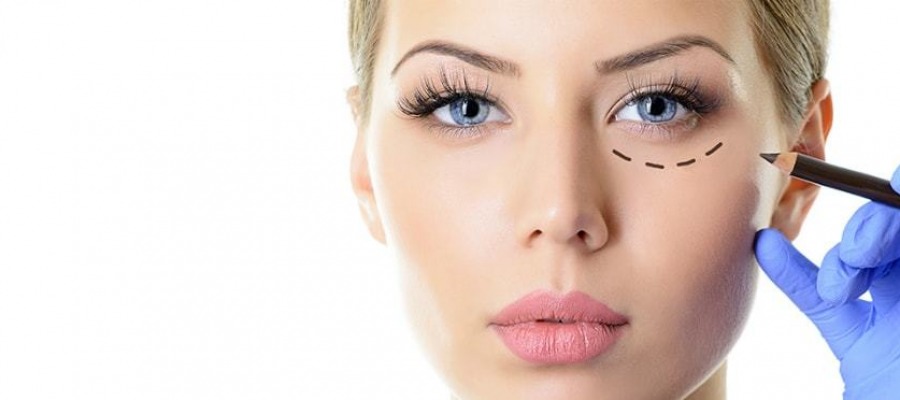PROCEDURE DURATION: from 30 minutes to 1 hour
TYPE OF ANESTHESIA:
WHAT IS BLEPHAROPLASTY??
The blepharoplasty reduces the excess skin of the eyelids and/or allows to remove the fat bags present, improving the aesthetic appearance of the eye, and then of the face.
WHO IS SUITABLE TO BLEPHAROPLASTY?
Blepharoplasty is recommended if you have:
- eye bags, due to periorbital fat accumulation
- eyes drooping, sagging shape of the eyelids, which gives a sad and tired look
- excess skin above the eyes covering the eyelid crease
- crow’s feet and sagging skin
- eyelid swelling that often causes small and annoying problems, such as redness, tearing or tunnel vision

PRE-OPERATIVE, WHAT TO DO BEFORE SURGERY?

Before a thorough medical examination will be performed. They will be required laboratory tests, electrocardiogram and possibly a chest x-ray. It’s also important to perform a complete eye examination to minimize the possible occurrence of complications related to pre-existing conditions not obvious clinically.
It is not advisable to perform surgery immediately before or during menstruation.
It’s better to suspend at least 3 days before the smoke of cigarettes.
They also suggest the suspension of drugs capable of altering blood coagulability such as aspirin or anti-inflammatory drugs, however, any practised therapy must be discussed with the surgeon.
HOW BLEPHAROPLASTY WORKS?

The blepharoplasty can be practised on the upper eyelid, lower or both (full blepharoplasty). The incisions and the resulting scars are positioned on the upper eyelid (at the level of the eyelid crease) and at times may protrude a few millimetres from the archway orbital. At the level of the lower eyelid, however, the scars are only a few millimetres from the lower ciliary margin.
The surgeon separates the skin tissue from the adipose tissue and muscle, removing excess portions, as in the case of bags under the eyes. The sutures are practised to leave minimum scars, however, that will match with the natural folds of the upper and for the lower eyelid blepharoplasty, you will find just below the eyelid.
lower eyelid: the incision is usually performed at about 1-2 mm from the ciliary margin parallel to the eyelid margin and it extends for about 1 cm laterally to the outer corner of the eye, hidden among the natural periorbital wrinkles. The skin is gently detached from the underlying tissues. An appropriate amount of excess fat is removed and, if necessary, excess skin is also removed.
In selected cases, you can remove the lower bags through the conjunctiva (no external incisions) by a transconjunctival blepharoplasty.
Upper Eyelid: excess skin is evaluated and so designed that the final scar may fall into a normal skin fold when the eye is open. In the region of the outer canthus the incision curves slightly upwards. The amount of established skin is removed as well as, possibly, an adequate amount of excess fat.
It can sometimes be indicated complementary procedures or support of the eyelid such as canthopexy or canthoplasty aimed at changing the shape of the eyes.
The skin wrinkles around the eye region can be treated with laser or botulinum toxin.
HOW MUCH TIME DOES THE SURGERY TAKES AND HOW LONG IS THE RESULT?
The blepharoplasty is practised under local anaesthesia, usually in combination with intravenous sedation, so as not to be completely alert during surgery or general anaesthesia depending on the case.
The surgery lasts from 30 minutes to 1 hour depending on the complexity and whether it is upper, lower or full (blepharoplasty superior-inferior) blepharoplasty.
The duration of the procedure result varies from individual to individual. In many cases, the bags of the lower eyelids do not recur, but over time, the skin becomes more lax, more redundant and could be necessary for a time-varying between 5-10 years, a further reduction of the skin.
POST-SURGERY: WHAT TO DO AFTER BEING OPERATED?
After the surgery and for the first 24 hours a slight dressing of ice-cold tablets will be applied to the eyes and that will be changed frequently. You may need to practice medical therapy (antibiotics, anti-oedema, pain relievers) or make use of eye drops and artificial tears for a few days.
This type of surgery involves minimal pain. Oedema, conjunctival hyperemia, bruising and discolouration (swelling, redness and discolouration) may be modest or substantial and in any case, vary from patient to patient. Most oedema and of the ecchymosis disappears between the fifth and tenth day, but it is not unusual that colour changes last longer. During this period the eyelids may appear swollen, irregular and asymmetrical. It will also be possible modest lacrimation and a sense of discomfort to light.
The stitches will be removed after 4-5 days from the operation.
Generally, it is advisable to read and watch television after 2-3 days and to stay away from heat sources. For two weeks it will be preferable to avoid hot environments and direct exposure to the sun for at least two months.
The work and social activities will be restricted for 10-15 days after surgery.
The make-up is possible after 2 weeks.
The driving can be resumed after one week.
These times are susceptible to individual variations.


